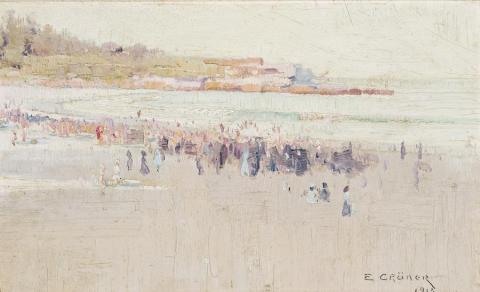FIGURES AT COOGEE, 1913
Elioth Gruner
oil on board
15.0 x 23.5 cm
signed and dated lower right: E. GRUNER / 1913
Leonard Joel, Melbourne, March 1982
Private collection, Sydney
Sotheby’s, Sydney, 23 - 24 May 1999, lot 588, (illus.)
Martin Browne Fine Art, Sydney
Private collection, Sydney
Elioth Gruner 1882 - 1939, Art Gallery of New South Wales,13 July - 4 September 1983, cat. 6 (label attached verso)
Pearce, B., Elioth Gruner 1882 - 1939, Art Gallery of New South Wales, Sydney, 1983, p. 33
Elioth Gruner's early beach scenes of Bondi, Coogee and Manly are among his finest works. In Figures at Coogee, 1913, the easy brilliance of his technique invented a quality of light that is still unrivalled in the history of Australian art. It was a highly creative time for Gruner, who produced during the years 1912 to 1914 such shining masterpieces as Bondi Beach, c.1912, in the collection of the Art Gallery of New South Wales, Manly, c.1912-13, in a private collection, and The Wave, c.1913, Queensland Art Gallery. Comparable in quality and related in subject to Figures at Coogee, Gruner focused his attention on figures promenading, seated on the sands, or bathing, integrating them so successfully with their surroundings that they seem as one, in close harmony with each other. In Figures at Coogee, for example, the broad, flat spread of the beach leads to the lively vertical accents of the figures, balanced again by the majestic curves of the waves, the tones and textures of the figures repeated in the rocky headland, balance maintained in the interplay of horizontal and vertical brush strokes loaded with subtle hues. The atmospheric haze and languid mood of a hot summer's day continues even into the sea, where the surf gives way to an indolent breaking of the waves, lazy in the noonday sun. It likewise envelops the viewer, for it is the kind of painting that, while inspired by the eye, comes very much from the heart. Smallness of size adds to its special appeal, more intimate, more personal than the bigger works in the series. This is continued in the felicitous influence of Whistler and Japonisme, painterly in figuration and narrow of format.
Gruner loved the Sydney beaches. He was a keen body-surfer, moving to Bondi in 1912 and later living much of his life at Tamarama. He even titled one of his 1913-14 paintings ‘The Jewelled Beach’. During the summer of 1912-13 Gruner and his friends Jack Lecky and his niece Gladys spent much of their week-ends on the beach. They both feature in the works Gruner was busily painting. In the 1913 annual exhibition of the Society of Artists, Gruner showed fifteen paintings, nine of which were of harbour and beach scenes. Of these, four were of Coogee, including Little Coogee and The Crowd on the Beach, Coogee. All were sold. While his large canvas, Spring Morning, Sydney Harbour, made, in the critic's words, ‘a hit this year’, his ‘smaller successes’ were also favourably noted, admired for their ‘atmosphere’ and ‘clever study of sunlight’.1
1. ‘Society of Artists. Annual Exhibition’, Sydney Morning Herald, 22 November 1913, p. 4
DAVID THOMAS
